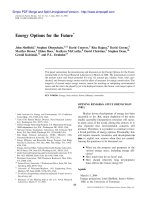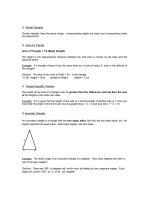Energy Options for the Future phần 3 pdf
Bạn đang xem bản rút gọn của tài liệu. Xem và tải ngay bản đầy đủ của tài liệu tại đây (829.54 KB, 10 trang )
Energy efficiency concepts include:
Conservation: behavioral changes that reduce
energy use.
Energy efficiency: permanent changes in
equipment that result in increased energy
services per unit of energy consumed.
Economic potential for energy efficiency: the
technically feasible energy efficiency mea-
sures that are cost-effective. This potential
may not be exploited because of market fail-
ures and barriers.
During the past century world energy consump-
tion has grown at a 2% annual rate. If this rate were
to continue, there would be a need for 7 times more
energy per year in 2100. In the U.S. the energy
consumption is growing at a 1–1.5% annual rate. At
the 1% level this would lead to a 28% increase by
2025 and 2.7 times increase by 2100. If the energy mix
remains the same, this will lead to a growing shortfall
and increasing imports.
In the U.S. 39% of energy consumption is in
residential and commercial buildings, 33% in indu s-
try, and 28% in transportation. Numerous studies
have been made by groups of DOE’s laboratories of
the potential for improved energy efficiency [Scenar-
ios of U.S. Carbon Reduction (1997) (www.ornl.gov/
Energy_Eff), Technology Opportunities to Reduce
U.S. Greenhouse Gas Emissions (1998) (www.ornl
gov/climate_change/cl imate.htm), Scenarios for a
Clean Energy Future (2000) (www.ornl.gov/ORNL/
Energy_Eff/CEF.htm and Energy Policy, Vol. 29, No
14, Nov. 2001)].
Implementing Current Technologies
In ‘‘California’s Secret Energy Surplus: The
Potential for Energy Efficiency’’ by Rufo and Coito
(2002: www.Hewlett.org) it is estimated that Califor-
nia has an economic energy savings potential of 13%
of base electricity usage in 2011 and 15% of total base
demand in 2011.
Similarly, in ‘‘Natural Gas Price Effects of
Energy Efficiency and Renewable Energy practices
and Policies’’ by Elliott et al., Am, Council for an
Energy Efficient economy (2003: ) it is
estimated that the U.S. could reduce electricity
consumption by 3.2% and natural gas consumption
by 4.1%.
Inventing and Implementing New Technology
Estimates have been made of the upper limits on
the attainable energy efficiency for non-electric uses,
by 2100, of 232% for residential energy consumption
and 119% for industry—‘‘Technology Options’’ for
the Near and Long Term (2003) (www.climate.tech-
nology.gov), and ‘‘Energy Intensity Decline Implica-
tions for Stabilization of Atmospheric CO
2
content
by H,’’ by Lightfoot and Green (2002) (www.mcg-
ill.ca/ccgcr/). The goal of the study ‘‘Scenarios for a
Clean Energy Future’’ was ‘‘to identify and analyze
policies that promote efficient and clean energy
technologies to reduce CO
2
emissions and improve
energy security and air quality.’’
The following U.S. energy policies were consid-
ered in the ‘‘advanced scenario’’:
g
Fig. 17. The model predicts that production may peak before proved reserves (caveat).
83Energy Options for the Future
Buildings: Efficiency standards for equipment
and voluntary labeling and deployment
programs.
Industry: Voluntary programs to increase
energy efficiency and agreements with aindi-
vidual industries.
Transportation: Voluntary fuel economy
agreements with auto manufacturers and
‘‘pay-at-the-pump’’ auto insurance.
Electric Utilities: Renewable energy portfolio
standards and production tax credits for
renewable energy.
Cross-Sector Policies: Doubled federal R&D
and domestic carbon trading system.
The advanced scenario would reduce energy use
by about 20% from the business-as-usual case, by
2020, see Figure 18. It would also reduce carbon
emissions by about 30%—notably 41% in the pulp
and paper industry.
More detailed conclusions of this and other
studies are given below.
Buildings Sector
Residential buildings: Efficiency standards and
voluntary programs are the key policy mechanisms.
The en d-uses with the greatest potential for energy
savings are space cooling, space heating, water
heating, and lighting. Primary energy consumption
in 2001 is shown in Figure 19.
A good example of continuing progress over the
past 30 years is the reduction in energy use of a
‘‘standard’’ U.S. refrigerator, from around
1800 kW h/year in 1972 to around 400 kW h/year in
2000, see Figure 20. At the same time CFC use was
eliminated. It is estimated that DOE research from
1977 to 1982, translated into commercial sales saved
consumers $9B in the 1980s. Projected energy saving
by owing to research in the 1990s is estimated to be 0.7
quad/year by 2010.
A ‘‘Zero Energy’’ house i.e., using only solar
energy, has been built as part of The Habitat for
Humanity program. It is up to 90% more efficient
than a typical Habitat home.
Commercial buildings: Voluntary programs and
equipment standards key policy mechanisms. Among
the opportunities to improve building energy use are
(Figure 21):
Solid-state lighting integrated into a hybrid
solar lighting system.
Smart windows.
Photovoltaic roof shingles, walls and
awnings.
Solar heating and superinsulation.
Combined heat and power-gas turbines and
fuel cells.
Intelligent building systems.
g
Fig. 18.
84 Sheffield et al.
Industry Sector
Key policies for improvement are, voluntary
programs (technology demonstrations, energy audits,
financial incentives), voluntary agreements between
government and industry, and doubling cost-shared
federal R&D.
Key cross-cutting technologies include, co m-
bined heat and power, preventive maintenance,
pollution prevention, waste recycling, process
control, stream distribution, and motor and drive
system improvements. Numerous sub-sector specific
technologies play a role. Advanced materials, that
operate at higher temperature and are more
corrosion resistant, can cut energy use in energy
intensive industries e.g., giving a 5–10% improve-
ment in the efficiency of Kraft recovery boiler
operations and 10–15% improvement in the steel
and heat treating areas.
A systems approach to plant design is illustrated
in Figure 22.
Opportunities exist to convert biomass feed-
stock—trees, grasses, crops, agricultural residues,
animal wastes and municipal solid wastes—into fuels,
power, and a wide range of chemicals. The conver-
sion processes being investigated and improved are
enzymatic fermentation, gas/liquid fermentation, acid
g
Fig. 19.
Fig. 20.
85Energy Options for the Future
hydrolysis/fermentation, gasification, combustion
and co-firing.
Transportation Sector
In the advanced scenario passenger car mpg
improves from 28 to 44 mpg owing to, materials
substitution (9.7%), aerodynamics (5.4%), rolling
resistance (3%), engine improvements (23.9%), trans-
missions (2.9%), accessories (0.4%), gasoline-hybrid
(12.6%), while size and design ()2.9%) and safety and
emissions ()1.1%).
Improvements in engine efficiency are being
developed to allow a transition to a hydrogen econ-
omy. It is anticipated that efficiency will improve from
35 to 40% in today’s engines to 50–60% in advanced
combustion engines, owing to advances in emission
controls, exhaust, thermodynamic combustion, heat
transfer, mechanical pumping, and friction. This
progress will facilitate the transition from gasoline
diesel fuels, through hydrogenated fuels to hydrogen
as a fuel. On-board storage of hydrogen is an area
requiring improvement. If these improvements are
Fig. 22.
Fig. 21. The end-use energy distribution in commercial buildings.
86 Sheffield et al.
realized, sales of gasoline powered vehicles might be
cut in half by 2020.
Power Sector
The use of distributed energy may increa se
because of improvements in industrial gas turbines
and micro-turbines that allow greater efficiency at
lower unit cost, the ability to have combined heat and
power and lower emissions e.g., it is projected that by
2020 micro-turbine performance will go from the
2000 levels of 17–30% efficiency, 0.35 pounds/MW h
of NO
x
and $900–1200/kW to 40% efficiency (>80%
combined with chillers and desiccant systems), 0.15
pounds/MW h of NO
x
and $500/kW. In the ad-
vanced scenario 29 GW will be added by 2010, and
76 GW by 2020. This would save 2.4 quads of energy
and 40 MtC of emissions.
High temperature superconducting materials
offer opportunit ies to improve the efficiency of
transmission lines, transformers, motors and genera-
tors. Progress has been made in all of these areas.
RENEWABLES: ELDON BOES (NRE L)
Resources
Renewable energy resources include:
Biomass
Geothermal
Hydropower
Solar
Wind
They may be used for electricity, fuel, heat,
hydrogen and light. The interest in them is because
they can have a low environmental impact. They
reduce dependence on imported fuel and increase the
diversity of energy supply. They can have low or zero
fuel cost with no risk of escalation. They offer a job
creation potential, especially in rural areas and there
is strong public support for them.
A map showing the widespread distribution
of renewable resources in the U.S. is shown in
Figure 23.
For solar energy, large areas of the world receive
an average radiation of 5 or more kW h/sq. m. per
day e.g., western China averages 6–8 kW h/m
2
per
day during the summer, and 2–5 kW h/m
2
per day
during the winter.
Solar and Wind Energy Resource Assessment
(SWERA)
This is a $3.6M program of the Global Envi-
ronmental Fund (GEF) designed to:
Accelerate and broaden the investment in
solar and wind technologies through better
quality and higher resolution resource assess-
ment.
Demonstrate the benefits of assessments
through 13 pilot countries in 3 major re-
gions.
Fig. 23.
87Energy Options for the Future
Engage country partners in all aspects of the
project.
The countries are Bang ladesh, Brazil, China,
Cuba, El Salvador, Ethiopia, Ghana, Guatemala,
Honduras, Kenya, Nepal, Nicaragua, and Sri
Lanka.
A medium resolution mapping of potential solar
energy in Sri Lanka shows a resource of typically 5–
6 kW h/m
2
per day during December to February,
and 4.5–5.5 kW h/m
2
per day during May to
September. Similar maps have been made for wind
speed showing some regions with a moderate
(6.4–7.0 m/s at 50 m) to excellent (7.5–8 m/s at
50 m) classification.
Wind Power
An example of a modern large turbine of
3.6 MWe is shown in Figure 24. For perspective note
that the blade diameter is comparable to the span of a
747.
In the U.S. as wind power capacity has increased
the cost of electricity (COE) has come down, see
Figure 25. California with 2011 MWe and Texas
with 1293 MWe lead in capacity. The total installed
capacity on the world is 37,220 MWe (on average
about 12,500 MWe) with:
14,000 MWe in Germany,
6374 MWe in the U.S.,
5780 MWe in Spain,
3094 MWe in Denmark, and
1900 MWe in India.
Achievements and Status
Cost of energy reduced to 3.5–5.5 cents/
kW h.
Wind resources are vast, but also vary con-
siderably on both regional and micro-levels.
Global capacity increasing at 20% per year.
Green power markets in U.S. are stimulating
100s of MWs.
g
Fig. 24.
Fig. 25.
88 Sheffield et al.
Recent energy costs are also accelerating
interest in wind power systems.
Bird kill issue appears to be manageable.
Not in my backyard remains an issue for
some proposed sites.
Likely Advances
Larger turbines: 3+ MW.
Expanding field experience will support both
technology and business development.
Low wind speed turbines.
Advanced power electronics.
Win resource forecasting will enhance
systems value.
Major transmission systems to tap Great
Plains resources.
Offshore wind power plants in shallow and
deep water.
Geothermal Power
Achievements and Status
The technology has been used at the
Geyser’s site in northern CA since the 1960s.
Quite a few additional systems have been
built in the past 20 years.
Advances in resource mapping and access.
Advances in conversion technologies—binary
systems and heat exchangers.
High quality resources in the U.S. are lim-
ited.
Likely Advances
Broad utilization of high-quality resources
around the globe.
Major challenges are resource characteriza-
tion and extraction.
– Where is it?
– How large and durable?
– Cheaper drilling.
Benefits will come from seismic mapping and
extraction technologies used in the oil & gas
industries.
Hot dry rock technology has long term
prospects.
Solar Thermal Electric
Achievements and Status
350 MW of parabolic trough plants built
around 1990 still operate well.
Several power tower demonstration plants
have established technology viability.
Several dish systems have also operated
successfully.
The challenges are system size and cost.
Potential Advances
There are major opportunit ies for technol-
ogy advances in:
g
Fig. 26.
89Energy Options for the Future
– Collectors.
– Power conversion.
– Thermal storage.
New systems are planned in Spain and
Nevada.
Success with new systems will catalyze
manufacturing advances.
Solar Buildings
Worldwide there are 4.5 million water heating
systems installed. The typical cost of 8 c/kW h is
projected to drop to 4 c/kW h.
Several hundred transpired collectors for air
heating have been inst alled worldwide. Their current
cost is around 2 c/kW h.
Zero net energy buildings, in which annual
production equals use, have been demonstrated.
Solar Photovoltaics
Photovoltaics already provide cost-effective elec-
tricity in small power units where there is no
electricity grid e.g., for pumping water, providing
lighting, and operating remote equipment. Larger
systems have been installed on a number of buildings
as illustrated in Figure 27.
The world PV market continues to grow steadily
as shown in Figure 28. While U.S. production is
increasing it lags the worldwide rates of increase.
Japan is the major producer with nearly 50% of the
production in 2002.
Photocell effici ency for all types of cell has
improved markedly over the past 27 years as shown
in Figure 29. At the same time, as the cumulative
production has increased the price of a PV module
has decreased steadily, see Figure 30.
Achievements and Status
Steady prog ress in increasing cell efficiencies
for 20 years.
Sales increasing 25%/year.
Major expansions of manufacturing capaci-
ties underway.
Value of building-integrated systems gaining
recognition.
U.S. owned manufacturing is losing ground.
Very substantial subsidies in Japan and Eur-
ope.
Likely Advances
Large potential for technol ogy and manufac-
turing advances.
Significant increases in conversi on efficiency
likely.
Organic and polymeric cells being
researched.
Standardized power controls and intercon-
nection equipment.
Better understanding of PV’s distributed
resource and peaking load values.
Fig. 27.
90 Sheffield et al.
Biomass
Resources
The resources of biomass are large and
widespread: trees and various crops, switchgrass,
agriculture and forestry residues—such as wood
chips, sugar cane residue, and manure—and munici-
pal solid wastes.
Biomass Electricity
In the U.S. there is 9700 MWe of capacity from
direct combustion of biomass and a further 400 MWe
from co-firing with coal. Biomass gasification is being
tried in small 3–5 kW systems in field verification
tests. Larger systems have been demonstrated.
Ethanol and Bioethanol
Ethanol is made from the starch in corn kernels.
It is available blended in motor fuels at a cost of
about $1.22/gal.
Bioethanol is made from cellulosic materials such
as corn stalks and rice. The technology is under
development and the cost is about $2.73/gal and
projected to drop to #1.32/gal. In the near-term it is
used as a fuel blend. In the longer- term as a bulk fuel
it will require energy crops.
Fig. 29.
Fig. 28.
91Energy Options for the Future
The New Bio-Industry
There are numerous uses for biomass as illus-
trated in Figure 31 and research is ongoing to
improve the conversion processes. One vision is to
develop a biorefinery in which feedstock is converted
by various processes to produce electricity, fuel
ethanol, and other bioproducts.
Hydrogen
Hydrogen is one of the many potential products
of biomass, but it can also be produced from other
renewable energies by electrolysis, photochemical
water splitting and through solar assisted produc-
tion.
A Transition to Renewables Scenario
A transition to renewable energies will require
‘‘getting serious" about adopting significant amounts.
An analysis was made of using renewable energies for
some of the expected added capacity and replace-
ments of capacity from 2006 to by 2020. DOE/E PRI
costs for renewables and DOE-EIA costs for con-
ventional power sources were used. Costs for trans-
mission of wind, geothermal and solar thermal were
added. It was assumed that the energy mix would be
Fig. 30. PV module production experience (or ‘‘Learning") Curve.
Fig. 31.
92 Sheffield et al.









